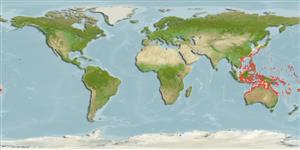Environment: milieu / climate zone / depth range / distribution range
Ecología
marino demersal; rango de profundidad 3 - 43 m (Ref. 106976). Tropical; 37°N - 27°S, 107°E - 178°W (Ref. 106976)
Distribución
Países | Áreas FAO | Ecosistemas | Ocurrencias, apariciones | Point map | Introducciones | Faunafri
Indo-West Pacific: from southern Japan (except Ryukyu Islands), Vietnam, Indonesia, Papua New Guinea, Fiji, Australia, Taiwan, India, and the Red Sea.
Tamaño / Peso / Age
Maturity: Lm ? range ? - ? cm
Max length : 12.0 cm TL macho / no sexado; (Ref. 48635)
Espinas dorsales (total): 12; Radios blandos dorsales (total): 9; Espinas anales 2; Radios blandos anales: 6. This species is distinguished by the following characters: A II,6; dorsal-fin spines flexible, bend easily under slight pressure; snout is relatively short, 12.3-17.0% (mean 14.3%) of SL, it is shorter than postorbital length; posterior margin of maxilla reaching to or extending beyond vertical through middle of pupil; the distance between tips of lateral lacrimal and the first suborbital spines is shorter than or subequal to that between tips of first and second suborbital spines; no supplemental preopercular spine; tentacles on supraocular and posterior lacrimal spines are well developed, their lengths greater than orbit diameter; trunk and fins with numerous tentacles; lateral lacrimal and suborbital spines are poorly developed, indistinct, usually tiny spines and often bony protuberances without pointed tips; absence of distinct black blotch on soft-rayed portion of dorsal fin (Ref. 106976).
This species lives primarily in algae or soft-bottom habitats (Ref. 48635); it can be easily overlooked because of its superb camouflage (Ref. 54980). Solitary among weed or on mud bottoms (Ref 90102).
Life cycle and mating behavior
Madurez | Reproducción | Puesta | Huevos | Fecundidad | Larva
Motomura, H. and Y. Kanade, 2015. Review of the scorpionfish genus Pteroidichthys (Scorpaenidae), with descriptions of two new species. Zootaxa 4057(4):490-510. (Ref. 106976)
IUCN Red List Status (Ref. 130435)
Threat to humans
Harmless
Human uses
Más información
PaísesÁreas FAOEcosistemasOcurrencias, aparicionesIntroduccionesStocksEcologíaDietacomponentes alimenticiosconsumo de alimentoRación
Nombres comunesSinónimosMetabolismoDespredadoresEcotoxicologíaReproducciónMadurezPuestaAgregación para la puestaFecundidadHuevosEgg development
ReferenciasAcuiculturaPerfil de acuiculturaRazasGenéticaElectrophoresesheritabilidadEnfermedadesProcesamientoNutrientsMass conversion
ColaboradoresImágenesStamps, Coins Misc.SonidosCiguateraVelocidadTipo de nataciónSuperficie branquialOtolitosCerebrosVisión
Herramientas
Special reports
Download XML
Fuentes de Internet
Estimates based on models
Preferred temperature (Ref.
123201): 24.7 - 29, mean 27.9 °C (based on 720 cells).
Phylogenetic diversity index (Ref.
82804): PD
50 = 0.5625 [Uniqueness, from 0.5 = low to 2.0 = high].
Bayesian length-weight: a=0.01259 (0.00606 - 0.02615), b=3.03 (2.86 - 3.20), in cm total length, based on LWR estimates for this (Sub)family-body shape (Ref.
93245).
Nivel trófico (Ref.
69278): 3.6 ±0.6 se; based on size and trophs of closest relatives
Resiliencia (Ref.
120179): Alto, población duplicada en un tiempo mínimo inferior a 15 meses (Preliminary K or Fecundity.).
Fishing Vulnerability (Ref.
59153): Low vulnerability (10 of 100).
